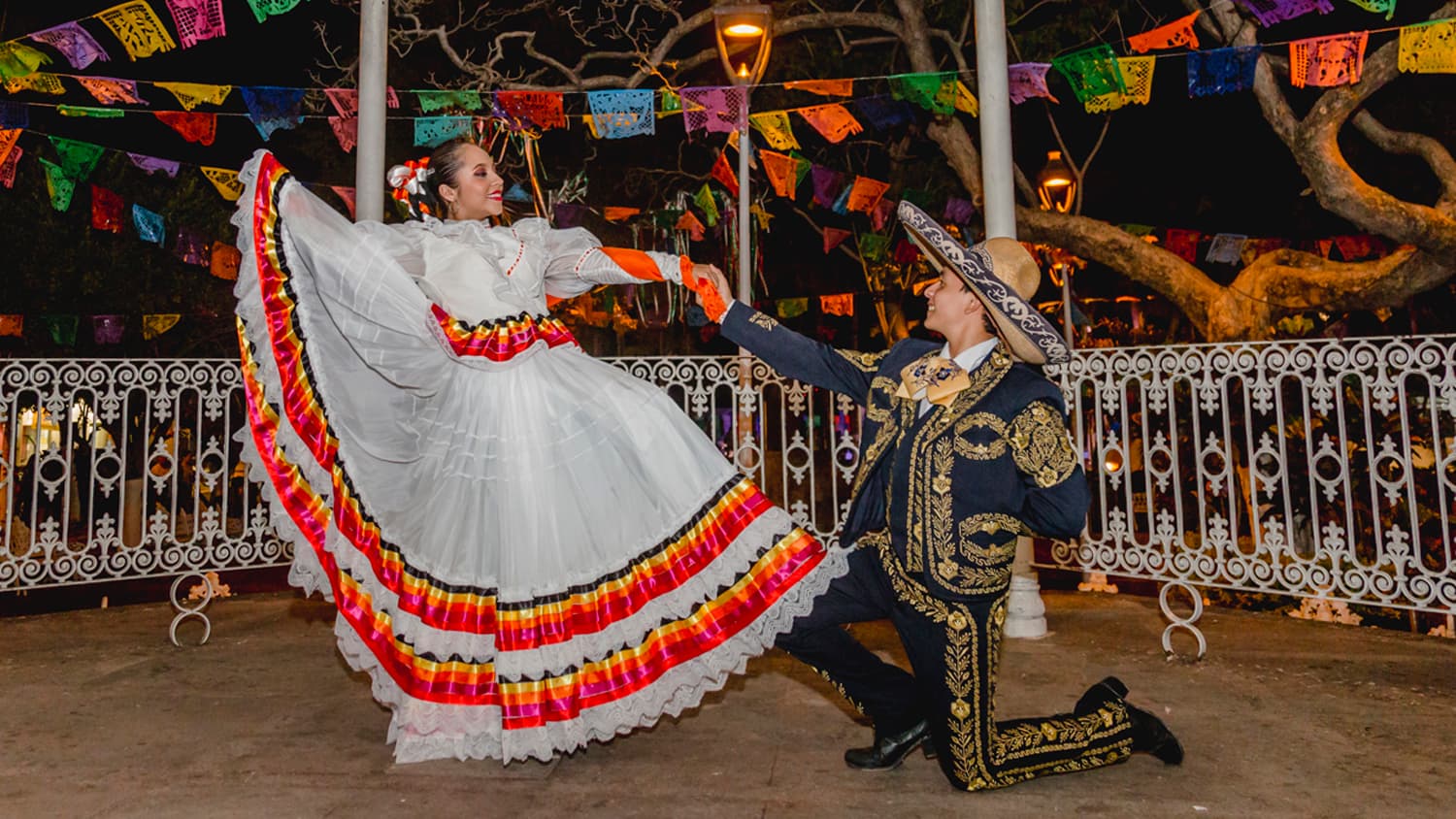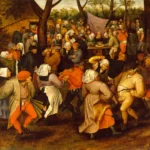Get ready to dive into the exciting world of Mexican dancing! Take a closer look at Jarabe Tapatío, Mexico’s national dance. We’ll explore where it came from, how it’s changed over time, and why it’s so important to Mexican culture. Get ready for a fascinating journey as we uncover the stories and traditions behind this beloved dance.
History of Jarabe Tapatío
Imagine this: It’s the 1800s in Guadalajara, Mexico, and a new dance is captivating hearts and turning heads. That dance? Jarabe Tapatío, often called the “Mexican Hat Dance” today. However, this wasn’t just any dance; it was a cultural fusion, blending the fiery steps of Spanish flamenco, like “zambra” and “jarabe gitano,” with the unique expressions of indigenous Mexican dances.
As with anything deemed a little too daring or provocative, the Spanish authorities, in an attempt to maintain control, tried to ban Jarabe Tapatío. But their efforts backfired. The ban only intensified its appeal, transforming it into a symbol of rebellion, a way for the Mexican people to cling to their heritage and declare, “This is who we are!”
Fast forward to the 1920s. Mexico, newly independent and eager to celebrate its unique cultural identity, chose Jarabe Tapatío as its national dance. With its infectious energy, vibrant costumes, and powerful storytelling, it wasn’t merely a dance; it was a symbol of Mexican pride and resilience.
But what story does this dance tell? It’s a classic tale of love and pursuit. A man, captivated by a woman, tries to win her over with his impressive footwork. She, in turn, plays hard to get, at least initially. He tosses his sombrero on the ground, and they dance around it, their steps drawing them closer. Finally, she picks up the hat, and in a grand gesture of affection (and some serious skill!), he kicks his leg right over her head! The dance concludes with their faces hidden behind the hat, leaving the ending open to interpretation. Is it a happy embrace or a playful rejection?
Jarabe Tapatío is more than just a series of steps; it’s a vibrant tapestry of Mexican culture. It’s woven with stories, traditions, and emotions passed down through generations. It’s a reminder of Mexico’s past struggles and triumphs, and its vibrant spirit continues to captivate audiences all over the world.
Does el Jarabe Tapatío tell a story?
Absolutely! Jarabe Tapatío is more than just fancy footwork; it’s a mini-drama unfolding on the dance floor. It’s a charming love story told through every stomp, clap, and twirl, starring a handsome charro (a traditional horseman) and a beautiful china poblana (a woman in a stunning dress).
Here’s how the story unfolds:
- First Impressions Matter: The charro, completely smitten, shows off his fancy footwork to impress the china poblana. But she, playing it cool, keeps her distance, as if to say, “I’m interested, but you’ll have to work for it!”
- Ouch, Rejection Hurts: Initially, the charro is left feeling rejected by the china poblana’s aloofness. He steps aside, perhaps seeking solace (or drowning his sorrows) with a drink.
- Making Up (and Showing Off!): This being a love story, there’s a happy resolution. The china poblana, noticing the charro’s distress, softens her stance and offers him a comforting cup of tea. This act of kindness ignites a playful, energetic dance. Their steps mirror each other’s, their movements perfectly in sync, conveying a sense of unity.
Jarabe Tapatío’s cultural significance extends beyond the love story:
- A Gesture of Respect: The charro lays down his sombrero at the china poblana’s feet, a sign of deep respect and surrender. Her graceful dance around the hat signifies acceptance of his love and devotion.
- The Spirit of Mexico: The dance is a symbol of Mexico itself – a vibrant fusion of indigenous and Spanish influences reflecting the country’s rich history and cultural tapestry.
To witness the magic firsthand, search for “Jarabe Tapatío” online. The passion, energy, and storytelling will leave you mesmerized. Jarabe Tapatío reminds us that some of the most powerful stories are told not with words, but through the language of movement and music.
When was Jarabe Tapatío banned?
Despite its popularity today, Jarabe Tapatío faced its share of controversy. In the late 1700s, the Catholic Church, a powerful force at the time, considered the dance too suggestive with its hip movements and close partnering and decided to ban it.
As you might imagine, this only fueled Jarabe Tapatío’s popularity. It transitioned into a hidden language, a form of rebellion against societal rules, performed in secret gatherings. This act of defiance solidified the dance as a symbol of Mexican identity, proving that cultural spirit could not be easily extinguished.
The ban’s unintended consequence was making Jarabe Tapatío even more popular. It became an emblem of resilience and a testament to the enduring power of cultural expression.
Why is Jarabe Tapatío so popular?
Jarabe Tapatío’s enduring appeal lies in its ability to transcend cultural boundaries and resonate with audiences worldwide.
More Than Just Fancy Footwork:
Jarabe Tapatío is more than just steps and music; it tells a story. The dance depicts a classic courtship, full of playful flirting and passionate expression. The emotions – longing glances, playful chases, and eventual surrender to love – are universally understood, regardless of language.
A Visual Fiesta for the Senses:
The visual spectacle of Jarabe Tapatío is undeniable. The colorful traditional costumes, the swirling skirts of the china poblana, and the proud stance of the charro are a feast for the eyes. The lively music, often played by mariachi bands, is impossible not to tap your foot to.
A Source of Mexican Pride – and Global Fascination:
For the people of Mexico, Jarabe Tapatío represents their heritage and national pride, a fusion of indigenous and Spanish cultures. Audiences worldwide are captivated by the passion and skill of the dancers, experiencing a glimpse into the heart of Mexican culture.
Jarabe Tapatío Today: Still Going Strong
Jarabe Tapatío is a dance that continues to evolve. You’ll find it performed at festivals and celebrations, in movies and television shows, and even in modern dance interpretations. Its ability to adapt ensures its relevance for new generations.
Jarabe Tapatío’s popularity can be attributed to its captivating story, its visual and auditory spectacle, and its profound connection to Mexican identity. It’s a dance that speaks to everyone, regardless of background.
Is Jarabe Tapatío the same as folklórico?
While Jarabe Tapatío is often called Mexico’s national dance, its classification as a traditional folk dance is sometimes debated.
Think of it this way: folklórico encompasses a vast repertoire of traditional dances from different regions of Mexico, each with its unique style and cultural significance. Jarabe Tapatío, originating in 19th-century Guadalajara, is a single, distinct dance with its specific origin story.
Folk dances are often passed down through generations, evolving with each new group of dancers. Some argue that Jarabe Tapatío has evolved beyond its folk roots into a more staged performance, while others believe adaptation is essential for keeping traditions alive.
The debate about Jarabe Tapatío’s place within the world of folklórico dance raises questions about cultural heritage and its definition. Despite varying perspectives, Jarabe Tapatío holds a special place in the hearts of many Mexicans, a symbol of national pride and a vibrant expression of Mexican culture that continues to captivate audiences worldwide.
What is the history behind Jarabe Tapatío?
Jarabe Tapatío’s roots can be traced back to 19th-century Guadalajara, Mexico. It’s believed to have originated, not on a formal stage, but as a playful courtship ritual among young people, a physical expression of affection set to music.
Ironically, colonial authorities, attempting to suppress this public display, banned the dance. This only fueled its popularity, transforming it into a symbol of defiance and a way for Mexicans to preserve their identity in the face of opposition.
Jarabe Tapatío’s captivating elements go beyond its steps. The costumes themselves are visually stunning – women in vibrant China Poblana dresses and men in dashing charro suits. Together, they present a captivating image of Mexico’s spirited soul.
The dance itself unfolds like a story – a man smitten with a woman attempts to win her affections. She, in turn, plays coy, initially resisting his advances. But as the dance progresses, it’s clear that she, too, is smitten. It’s a timeless tale of love and pursuit told through the captivating language of dance.
Over time, Jarabe Tapatío has transcended its humble beginnings to become a cherished national treasure. Performed at festivals, cultural events, and celebrations, it stands as a reminder of Mexico’s vibrant heritage.
What are some interesting facts about jarabe?
Often referred to as the “Mexican hat dance,” Jarabe Tapatío, a beloved symbol of Mexico, carries a rich history and deep cultural significance.
Emerging in 19th-century Guadalajara as a playful courtship dance, it quickly evolved into a powerful expression of national pride during Mexico’s fight for independence.
Several factors contribute to its lasting appeal:
- Universal Story: Jarabe Tapatío’s depiction of courtship, with its playful flirtation, eventual surrender, and passionate embrace, resonates across cultures.
- Vibrant Costumes: The dancers’ attire adds to the visual spectacle. Women wear the colorful, full-skirted China Poblana dress, while men don the traditional charro suit, each element rich with symbolism.
- Lively Music: The accompanying music, often played by mariachi bands, is infectious and adds to the celebratory atmosphere.
Jarabe Tapatío’s captivating blend of music, movement, and cultural storytelling has garnered international recognition, making it a beloved dance enjoyed worldwide.
Does folklórico tell a story?
Folklórico, Mexico’s vibrant tapestry of traditional dances, is more than just beautiful movements; it’s a living, breathing history book. Each dance tells a unique story, offering glimpses into Mexico’s diverse culture, history, and traditions.
Imagine folklórico as a collection of captivating tales waiting to be unraveled:
- Love Stories: Some dances depict the joys and sorrows of love, courtship rituals, and celebrations of passion.
- Historical Events: Others recount significant historical events, like the Spanish conquest or the Mexican Revolution, preserving the past through movement.
- Everyday Life: Dances also portray everyday life in different regions of Mexico, showcasing local customs, occupations, and celebrations, offering insights into the country’s diverse cultural landscape.
The costumes themselves are like pages from a history book. Their vibrant colors, intricate designs, and regional variations tell stories of their own, whispering secrets about Mexico’s cultural heritage.
Folklórico is more than just preserving the past; it’s about keeping traditions alive. Through these dances, communities connect with their roots and share their heritage. So, when you watch a folklórico performance, you’re not just watching a dance — you’re experiencing the living story of Mexico.
What is the story of Danza de los Diablos Oaxaca?
The Danza de los Diablos Oaxaca, also known as the Dance of the Devils, is a powerful expression of history and heritage deeply rooted in the Afro-Mexican communities of Oaxaca, Mexico. Its exact origins remain shrouded in mystery, like fragments of a story passed down through generations.
Some believe it originated during slavery as a prayer to the African god Ruja, a plea for liberation from oppression. Over time, it likely evolved into a vibrant celebration of survival and resilience, honoring ancestors, remembering their struggles, and keeping cultural traditions alive.
The dance itself is a visual spectacle. Dancers adorned in elaborate costumes, masks, and headdresses embody both good and evil spirits. Their intricate footwork, pulsating rhythms, and coordinated movements weave together stories of heritage, struggle, and the triumph of the human spirit.
The Danza de los Diablos Oaxaca is a testament to the enduring power of culture. It’s a vibrant thread in the rich tapestry of Oaxaca’s cultural landscape and a reminder of the indomitable spirit of the Afro-Mexican community.
What is the meaning of the Mexican hat dance?
The Mexican hat dance, officially known as Jarabe Tapatío, is more than meets the eye. It’s a lively performance and a powerful symbol of love, tradition, and Mexican pride.
In 19th-century Guadalajara, Jarabe Tapatío was a form of flirtation. The man, smitten with the woman, would try to win her over with his dance moves. She’d play hard to get, but his charm and skill would eventually win her over. The iconic hat gesture at the end, with the man laying down his sombrero for her to pick up, symbolized a declaration of affection.
Over time, Jarabe Tapatío transitioned from a playful courtship ritual to a powerful emblem of Mexican identity. The colorful, intricately embroidered costumes represent Mexico’s rich history and artistry. The dance itself is a staple at celebrations and cultural events, allowing Mexicans to connect with their heritage and express national pride.
Here’s a breakdown of the dance’s significance:
- National Pride: Jarabe Tapatío is considered Mexico’s national dance, embodying its cultural identity and spirit.
- Love Story: Through graceful steps and playful gestures, the dance tells a story of courtship, pursuit, and eventual surrender to love.
- Cultural Heritage: With its vibrant costumes and energetic music, Jarabe Tapatío captures the essence of Mexico’s rich cultural heritage.
What is the most popular dance in Mexico?
Mexico, a country bursting with cultural richness and diversity, boasts an array of captivating dances. Choosing just one as the “most popular” is no easy feat! However, the dance that instantly evokes images of Mexico for many is undoubtedly the Jarabe Tapatío, often referred to as the Mexican Hat Dance.
Jarabe Tapatío is more than just steps; it’s a mini-drama set to music, a tale of a charming charro (a traditional Mexican horseman) smitten with a beautiful woman in a vibrant China Poblana dress. Their dance is a playful pursuit, her initial hesitation melting into acceptance.
This dance is a whirlwind of energy and intricate footwork. The lively music, often provided by a mariachi band, adds to the festive atmosphere.
While Jarabe Tapatío’s exact origins are debated, its popularity surged in the 19th century, during a time of significant political change. Some believe it served as a way for Mexican people to express their national identity.
Today, Jarabe Tapatío graces a multitude of Mexican celebrations, from weddings to fiestas. Its appeal extends far beyond Mexico’s borders. The infectious energy, beautiful costumes, and captivating story resonate with audiences globally.
While Jarabe Tapatío might be the most widely recognized Mexican dance, many other regional dances are deeply cherished and culturally significant. Nevertheless, the “Mexican Hat Dance” holds a special place in many hearts, a potent symbol of Mexican culture that continues to captivate generations.
Want to Learn More About Mexican Culture and History?
Mexico’s rich cultural tapestry extends far beyond its vibrant dances. From its fascinating history to its unique traditions, there’s always something new to discover.
- To know more about the history of Hotel Parq Central Albuquerque, click here.
- Want to discover the history of Hummel figurines, click here.
- If you are interested to learn about the history of hurricanes in Cancun, click here.
- To gain more information regarding the history of hurricanes in St. Augustine, Florida, click here.
- Unlock Water’s Symbolism: A Cross-Cultural Exploration - April 20, 2025
- Identify Black and White Snakes: Venomous or Harmless? - April 20, 2025
- Unlocking Potential: Origins High School’s NYC Story - April 20, 2025















